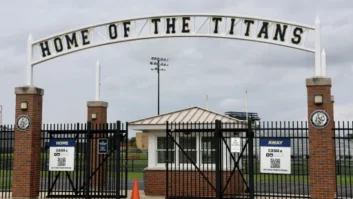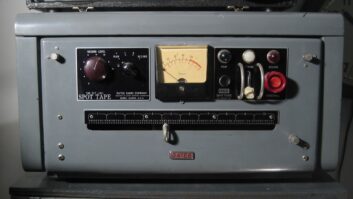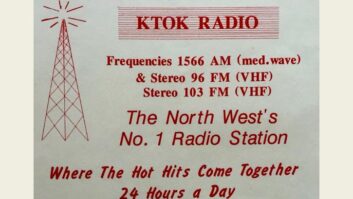Radio Kansas Rebuilds for its RF Future
Apr 1, 2012 1:00 AM, By Ric Jung

The tower is an ERI 1300′ stick including the 135′ lambda cantilever section with 12-bay ERI rototiller on top. There are two 10′ 950MHz grid dishes around 950′ feeding KHCT and KHCD. Lower down are the 950MHz and 5GHz studio links.
HD Radio offers the most intriguing possibilities of any U.S. industry development for radio broadcasting in many years. The challenge for many current HD Radio broadcasters has been to deliver an acceptable digital signal to autos, homes and offices without spending a fortune on equipment upgrades and higher power bills.
Radio Kansas is a three-station network broadcasting public radio to almost one million over-the-air listeners – nearly half the population of Kansas. Owned by Hutchinson Community College, the network comprises KHCC-FM, a 100kW station serving Wichita, Hutchinson and Newton; KHCD-FM, a 100kW station serving Salina, Manhattan and the north-central portion of the state; and KHCT-FM, a 50kW station serving the Great Bend and Hays communities to the west. All three stations air the same programming, including the premier NPR news programs and locally programmed classical music.

The KHPC transmitter room.
Radio Kansas went on the air with HD Radio in 2006, and recently launched an HD2 channel offering a jazz format. Active promotion has been restrained due to reception limitations at the standard -20dBc level. While mobile reception on the prairie is fine, building penetration has been more challenging.
This became instantly clear during a member event where listeners were invited into a local caf� to hear KHCD’s new HD Radio signal. We realized there was a problem with -20dBc when we couldn’t pick up enough of a signal to demonstrate the radio. As a result, HD Radio promotion to Radio Kansas listeners was put on hiatus until we were certain that signals could penetrate the typical home and office building.
It was around this time when the industry began discussing elevated sidebands of up to -10dBc to significantly increase HD Radio output power. We quickly developed a plan to upgrade all three transmission facilities to support elevated sideband levels.
– continued on page 2
Radio Kansas Rebuilds for its RF Future
Apr 1, 2012 1:00 AM, By Ric Jung

KHCT racks: Harris FlexStar exciter, Belar analog and HD monitors, Bird BPM series power monitors, backup Orban Optimod 8100 and TTC 8090X Exciter, Starlink dual receivers (space diversity) and Hitless Switch, Davicom MAC+ remote control, UPSs
The plan included supplementing existing Harris Z-Series solid-state transmitters with new high-power Harris HPX tube HD transmitters. The plan also revisited combining methods for the best possible efficiency, and required adjustments to HVAC and other systems to accommodate the high-power tube models. The primary engineering goal was to minimize equipment and ongoing utility costs.
KHCC, serving about 600,000 listeners, was the driving force for the entire project – though it was the final of the three upgrades to go live. Projections suggested that the move to -12dBc would significantly enhance HD Radio service to more than 385,500 people within the 60dBu contour, including the three principle cities. A Harris HPX40 transmitter – as in 40kW – was chosen for this site as it could provide -9dBc digital at 13,230W FM required in the transmitter combining plan.
KHCD was the first site to upgrade in the fall of 2011. We lit up an HPX30 (30kW), with just a bit of re-tuning required to operate through a combiner with the Z12HD+ for -14dBc operation. KHCT, at an asymmetrical -10/-14dBc, soon followed. We turned on an HPX20 (20kW) that ran right out of the box, with no combining. In February, KHCC’s HPX40 went on the air, providing a digital signal at -12dBc in conjunction with a Z16HD+.
Combining options

KHCT: Exciter rack with Harris FlexStar, backup Orban Optimod 8100 and TTC 8090X Exciter, Belar IBOC monitor, Bird BPM wattmeters and the two transmitters: Z6HD+ and HPX20
Radio Kansas underwent an intense period of research to determine the best possible method. We had been operating in the split-level combining method since launching HD Radio services. That method used one legacy transmitter for FM-only and a second transmitter for FM+HD. This was efficient at -20dBc.
The search was on to identify the most cost-effective way to upgrade the digital injection level from both a capital standpoint and with consideration of the ongoing operating costs. Power is increasingly expensive and makes up a significant portion of the Radio Kansas budget.
– continued on page 3
Radio Kansas Rebuilds for its RF Future
Apr 1, 2012 1:00 AM, By Ric Jung
Space combining was one option. This would have required a new antenna and considerable tower strengthening. The system at KHCC, for example, included an ERI SHP-12AC rototiller antenna. One approach to space combining would replace the existing rototiller with a new dual-input antenna. That was far too heavy for the cantilevered lambda section at the top of the tower, which is about 135′ long and designed specifically for the 12-bay SHP.
Dual-mode antennas are far heavier than standard FM antennas with much higher wind loads. The cantilever section of the tower, added two years prior, would require replacement – an expensive and inefficient endeavor. For example, the existing 12-bay antenna weighed 2,340 pounds with a wind load of 85 square feet; an ERI Lynx Series II dual-input antenna weighs 5,122 pounds with a wind load of about 217 square feet. (Both measurements estimate 1/2″ of ice on top.)

KHCC: RF plumbing that provides split-level combining in the ERI IBOX M-3 AND, with MCI 61304 switches, allows the station to bypass the combiner and put the Z16HD+ directly to air in any mode, FM or FM+HD for maintenance of HPX40. The old BE20B and HPX40 are also switchable.
Another space combining option was a second antenna at a lower tower position. This would have also required significant tower strengthening and additional costs to purchase and install the antenna and feedline – far exceeding the price of a new transmitter. The radiation patterns of the two antennas, at different places on the tower, would also not have matched due to differing tower cross-sectional dimensions (4′ lambda versus 7′). This would result in inconsistent analog/digital ratios and cause reception problems for listeners.
A third option would have added a Myat combiner to each system. This approach was about as expensive as a new transmitter, but the bigger concern was that the combiner would require its own climate-controlled room at each site. This meant expanding the transmitter buildings, as the combiner was about 4.5′ tall, 5′ wide and 9′ long.
Beyond all this, the existing transmitter could not accommodate the increased power levels with the current combining configuration. At KHCC, to use the legacy FM transmitter with the existing Harris Z16HD+ transmitter, the Z would need to provide 2kW of analog and 6kW of digital with the current 4.7dB combiner to make -10dBc. This is beyond its capacity.
With these options exhausted, a decision was made to re-engineer the split-level combining system and purchase HPX models to operate with the existing Z-Series models – a unique variation on the split-level method that essentially uses the same theory and connection patterns. The objective was to have one transmitter operate in the highly efficient Class C mode. The resulting architecture assigned the Z-Series models to this FM-only duty and assigned the new HPX transmitters to FM+HD in the Class AB mode.
– continued on page 4
Radio Kansas Rebuilds for its RF Future
Apr 1, 2012 1:00 AM, By Ric Jung

KHCC: another angle on the RF plumbing
Together, via 6dB ERI combiners, the systems deliver the required elevated digital signals to the existing antennas. For example, the KHCC system runs the HPX40 at 13,230W of FM power and 1,670W of HD Radio power. Combined with the Z16HD+ at 7,000W of FM power through a 6dB combiner, the resulting TPO is 20kW analog and 1,252W digital – equal to the full-licensed FM power and -12dBc HD Radio power. This combination minimizes transmitter power consumption, reject load power and cooling requirements.
HD+FM architecture
The three transmitter sites almost form a perfect triangle, with distances of about 90 miles between each tower. The delivery architecture from studio to transmitter sites is also a bit unusual, employing two-hop microwave paths from the flagship site (KHCC) to the distant tower sites.
At the studios, the main program audio comes from the main studio console; automation delivers HD2 program audio. Both are processed with Aphex Compellers for mild control and limiting. A Moseley StarLink microwave STL system carries the main program AES audio to the KHCC site, with a Harris Intraplex STL running over a 5.7GHz radio carrying HD2 program audio and high-speed data. Main program audio feeds an Omnia.6 on-air audio processor at the transmitter site, while the HD2 audio is fed directly to a Harris FlexStar HDE100 Importer.

KHCC: HPX40 that will be partitioned off from the room to allow ventilation of the cavity from behind. This will cut cooling requirements drastically.
Our HD Radio architecture uses a single Harris HDE100 Exporter for all three stations. The main program audio from the Omnia hits the Exporter, which outputs delayed FM audio and creates the UDP signal consisting of HD1, HD2 and associated program data (PSD). The UDP signal is distributed to the local and distant exciters through a Cisco switch and the data channel on the StarLink-based microwave radios. The main FM program audio remains in the AES format and is distributed similarly.
The FlexStar exciter is an amazing piece of machinery considering the way it simultaneously drives two transmitters. In the old split-level setup, the exciter’s main 55W output fed the legacy, FM-only transmitters. The auxiliary 10mW output handed off to a FlexStar BoostPro amplifier mounted in the Z transmitter. This was a nice textbook setup for additional power that worked very well.
The enhanced split-level configuration changed things around. The main 55W exciter output now feeds the Z-Series transmitters at each site, while the 10mW output feeds a BoostPro in each HPX.
The BoostPro is essentially a highly intelligent second power amplifier for the exciter. The reason for the change rests on the Flexstar exciter’s output port limitations that allow FM+HD from the auxiliary spigot when FM-only is selected on the main 55W output. The HPX and BoostPro have not yet been used together in the field, so specially-designed BoostPro configurations allow the HPX to recognize the BoostPro correctly as an exciter power amplifier – making Radio Kansas the first broadcaster to use the two components together.
– continued on page 5
Radio Kansas Rebuilds for its RF Future
Apr 1, 2012 1:00 AM, By Ric Jung

KHCC’s building includes spare 950MHz antennas and an 80kW diesel generator.
Overall, the FlexStar and BoostPro are very intelligent in their interactions with the transmitters, able to accommodate complicated, multi-mode switching on the fly and maintain power levels through integrated automatic power control (APC). Harris Real-Time Adaptive Correction technology, in correlation with the exciters, has been instrumental in flattening out sidebands to very low levels and keeping the signals within mask compliance. We experimented with upsetting the transmitter linearity by adjusting plate tuning/loading and adjusting bias and screen voltages. On queue, the system kicked in to smooth out the sidebands and minimize residual distortion products.
Transmitter choice
The choice to go with Harris really started in 2006 upon purchasing the FlexStar system and the Z-Series transmitters. Switching to another manufacturer would have been difficult as two of the three legacy FM transmitters we needed to use were from Harris. Our experience with Harris transmitters and Harris customer support was great, and it was important that this complex system be single-sourced.
So, why the HPX? Frankly, it was a gamble to consider a tube transmitter in the world of HD Radio, but the cost of putting two high-power solid-state transmitters side-by-side to supply the elevated digital signals would have been off the charts.
We also had reservations about whether a solid-state transmitter would be cheaper in the long run. Our final opinion was that a high-power tube might actually be less expensive for total cost of ownership. Harris explained that unheard-of tube linearity was achievable through careful bias and screen voltage selection. Factory tests proved they could achieve our digital injection values while maintaining HD Radio mask compliance.
It was also important to provide enough headroom in the FM+HD transmitter to move to other digital modes. The HPX40 at KHCC, for example, was effective as it had enough headroom to accommodate the extended service modes if and when we move beyond the MP1 service mode.
Reliability of operation was also key. Radio Kansas goes dark from midnight to 5 a.m. each day. Davicom MacPlus remote control systems shut down the transmitters each night at midnight with the filaments turning off 15 minutes later. Each morning, the filaments begin warming up at 4:45, and the transmitter plates kick on about 10 minutes later. This all happens automatically and dependably, even during the coldest winter nights.
Internally, the HPX transmitter layout is clean and simple. The power supply and cavity are accessible and easy to maintain. All controller cards are grouped in the front. The transmitters are sophisticated with multi-mode operation, adding new functions and adjustments beyond the standard Class C FM transmitter. This sophistication required study and experimentation to understand the interaction of the various parameters and cavity linearity.
Other changes were minimal. Davicom and Bird systems cleanly handle the remote control and onsite power readings, respectively, making meter and status readings available on demand. ERI 6dB mBoxM3 combiners connect and mix the two transmitters. The HPX transmitters and ERI combiners were added to existing RF plumbing using non-pressurized elbows, couplers and an additional 20′ length of 3-1/8″ non-flanged transmission line. No new transmission lines were required for the towers.
– continued on page 6
Radio Kansas Rebuilds for its RF Future
Apr 1, 2012 1:00 AM, By Ric Jung
Keeping costs low
The main concern about moving to elevated digital sidebands was that utility bills would go through the roof, not just from increased transmitter power requirements but also from new HVAC demands. We evaluated how efficient, or inefficient, our existing closed air conditioning systems would operate in the new setup.
Summer days in Kansas often exceed 100 degrees, topping out near 115. The HPX transmitters, being FM+HD and the highest power units in our systems, also generate the most heat. We opted to step back several decades and build partitions over the HPX transmitters that would create a plenum at the rear, leaving the front side air-conditioned and the back side ventilated with outside air. This ensures that the brains of the transmitter remain cool without requiring an additional 8 to 10 tons of cooling. This design will significantly reduce utility bills.
The KHCC and KHCD HVAC designs are identical. We positioned the backs of these transmitters into spaces resembling oversized closets, with fans hung on outside building walls. The filtered intake fan near the floor runs at about 2,000 CFM, bringing in outside air and pressurizing the space. A 1,500 CFM exhaust fan high on the outside wall and above the drop ceiling sucks hot air from the transmitter exhaust to the outside.
Radio Kansas is currently testing the extended coverage to mobile radios, the increased building penetration for indoor radios and the behavior of portable radios in both mobile and indoor environments. Initial tests appear promising. With the new systems up and running and operating well, our hope is that the tests prove that elevated sideband levels effectively improve our HD Radio coverage and allow us to freely promote HD Radio services to our listeners.
Jung is director of engineering at Radio Kansas, Hutchinson, KS.
April 2012
Audio over IP for remotes, Radio Kansas rebuilds, the FCC rules on translators and LPFM, and Field Reports on the Inovonics INOmini 632 and Nautel NV40….







